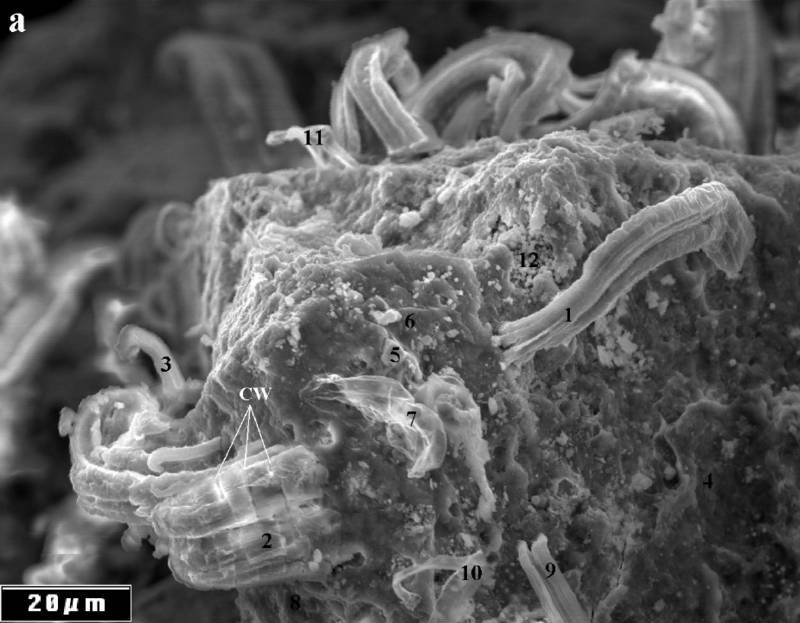What'sNEW March–April 2011
 29 April 2011 29 April 2011
 An analysis of long-running evolution experiments has been done by biochemist Michael Behe (pictured) of Lehigh University. The adaptive changes observed in the experiments come from genetic mutations like insertions, deletions, substitutions, rearrangements, etc. Regardless of their phenotypic consequences, Behe categorizes each mutated coding element as having undergone either a loss, modification, or gain of function. We welcome his attention to this important area of research.
An analysis of long-running evolution experiments has been done by biochemist Michael Behe (pictured) of Lehigh University. The adaptive changes observed in the experiments come from genetic mutations like insertions, deletions, substitutions, rearrangements, etc. Regardless of their phenotypic consequences, Behe categorizes each mutated coding element as having undergone either a loss, modification, or gain of function. We welcome his attention to this important area of research.
The best-known of these experiments are the ones by Richard Lenski's group at Michigan State. In 2008, this group observed aerobic citrate metabolism in E. coli, a surprise. However, the mutations behind this adaptation are unknown and thus could not be categorized in Behe's system. But Behe admits, "If the phenotype is due to one or more mutations that result in, for example, the addition of a novel genetic regulatory element, gene-duplication with sequence divergence, or the gain of a new binding site, then it will be a noteworthy gain-of-FCT mutation."
Behe concludes from his analysis, and logic, that gain-of-function is much rarer than loss- or modification-. And any gain, so far, must be simple, he thinks, because "...complex gain-of-FCT mutations likely would occur only on long time-scales unavailable to laboratory studies...." We note that 50,000 generations in a population that is large (compared to, say, primates, ten million years ago), and mutating at the prokaryotic rate, is not nothing. But if that's his viewpoint, would Behe consider looking at computer models of evolution? For them, enough time has already elapsed.
 Michael J. Behe, "Experimental Evolution, Loss-of-Function Mutations, and 'The First Rule of Adaptive Evolution'," [abstract], p419-445 v 85, Quarterly Review of Biology, Dec 2010. Michael J. Behe, "Experimental Evolution, Loss-of-Function Mutations, and 'The First Rule of Adaptive Evolution'," [abstract], p419-445 v 85, Quarterly Review of Biology, Dec 2010.
 Michael J. Behe, Ph.D., homepage at Lehigh University. Michael J. Behe, Ph.D., homepage at Lehigh University.
 Evolution versus Creationism is a related local webpage. (Search for "Behe".) Evolution versus Creationism is a related local webpage. (Search for "Behe".)
 In Real or Artificial Life, Is Evolutionary Progress in a Closed System Possible? argues the case for computer models and contains links to updates about Lenski et al., including one about the citrate metabolizers, described in What'sNEW, 5 Jun 2008, and mentioned, 13 Apr 2011. In Real or Artificial Life, Is Evolutionary Progress in a Closed System Possible? argues the case for computer models and contains links to updates about Lenski et al., including one about the citrate metabolizers, described in What'sNEW, 5 Jun 2008, and mentioned, 13 Apr 2011.
 Macroevolutionary Progress Redefined... describes our version of a loss/modification/gain system for classifying evolutionary changes in real life. Macroevolutionary Progress Redefined... describes our version of a loss/modification/gain system for classifying evolutionary changes in real life.
 20 Sep 2012: Richard Lenski's research group has analysed the evolution of aerobic citrate metabolism among cloned bacteria. 20 Sep 2012: Richard Lenski's research group has analysed the evolution of aerobic citrate metabolism among cloned bacteria.
 26 April 2011 26 April 2011
 Bacteria can grow at 400,000 Gs, according to a research team at the Japan Agency for Marine-Earth Science and Technology. Using a centrifuge to measure cell density, the researchers were surprised when the subject E. coli continued to multiply at 7,500 Gs. They decided to measure the upper limit of this capability and found that, for some species, it exceeds the highest G-force attainable with the centrifuge. They conclude, "the habitability of extraterrestrial environments must not be limited by gravity."
Bacteria can grow at 400,000 Gs, according to a research team at the Japan Agency for Marine-Earth Science and Technology. Using a centrifuge to measure cell density, the researchers were surprised when the subject E. coli continued to multiply at 7,500 Gs. They decided to measure the upper limit of this capability and found that, for some species, it exceeds the highest G-force attainable with the centrifuge. They conclude, "the habitability of extraterrestrial environments must not be limited by gravity."For example, these bacteria would certanly not be harmed by the surface gravity of only 10 to 100 Gs on failed stars known as brown dwarfs. Even the extreme acceleration from impacts powerful enough to launch meteorites into space would not kill them. Team member Shigeru Deguchi comments, "If life does exist in other places in the universe, our study provides further evidence that it could spread within solar systems by the mechanism often discussed in panspermia hypotheses -- i.e., impact-based transport of meteorites between bodies of the same solar system."
 Shigeru Deguchi et al., "Microbial growth at hyperaccelerations up to 403,627 × g" [abstract], doi:10.1073/pnas.1018027108, Proc. Natl. Acad. Sci. USA, online 25 Apr 2011. Shigeru Deguchi et al., "Microbial growth at hyperaccelerations up to 403,627 × g" [abstract], doi:10.1073/pnas.1018027108, Proc. Natl. Acad. Sci. USA, online 25 Apr 2011.
 Alien bacteria could breed in extreme 'hypergravity', by Mike Wall, Space.com (+msnbc.com), 25 Apr 2011. Alien bacteria could breed in extreme 'hypergravity', by Mike Wall, Space.com (+msnbc.com), 25 Apr 2011.
 Bacteria can grow under extreme gravity..., by Deborah Braconnier, PhysOrg.com, 26 Apr 2011. Bacteria can grow under extreme gravity..., by Deborah Braconnier, PhysOrg.com, 26 Apr 2011.
 Bacteria: The Space Colonists is a related local webpage. Bacteria: The Space Colonists is a related local webpage.
 Thanks, Sam McIntyre and Google Alerts. Thanks, Sam McIntyre and Google Alerts.
 20 April 2011 20 April 2011
Did transposons come from viruses? This would be interesting, because transposable elements of all types account for 50% to 90% of the human genome (versus 1.5% for ordinary genes). Transposons are known to move about within genomes, to be shared across distant species, and to affect evolution profoundly. But how genomes acquire them is not entirely clear. If they are derived from viruses, perhaps they are acquired as easily as viruses are.

Now a pair of Canadian microbiologists have shown a clear link between a large DNA transposon (lower strand in illustration), known by its initials, MP, found in a wide range of animals; and a virophage (upper strand) that they named Mavirus. (A virophage is a virus that infects other viruses.) The Canadians suspect that the widespread MP transposons "arose from the endogenization of an ancient relative of Mavirus." They even propose, "...Eukaryotes that are susceptible to infection by giant viruses will gain a selective advantage if they can associate themselves with virophages."
Viruses are efficient agents of horizontal gene transfer (HGT). Now we see additional evidence linking them to transposable elements, a clue that 50% to 90% of the human genome was acquired by HGT. This sounds preposterous to most darwinists, but it would be consistent with cosmic ancestry.
 Matthias G. Fischer and Curtis A. Suttle, "A Virophage at the Origin of Large DNA Transposons" [abstract], doi:10.1126/science.1199412, p231-234 v332, Science, 8 Apr (online 3 Mar) 2011. Matthias G. Fischer and Curtis A. Suttle, "A Virophage at the Origin of Large DNA Transposons" [abstract], doi:10.1126/science.1199412, p231-234 v332, Science, 8 Apr (online 3 Mar) 2011.
 The human genome contains about 1.8 million recognizable Alu sequence residues... — Roy Britten, What'sNEW, 21 Nov 2010. The human genome contains about 1.8 million recognizable Alu sequence residues... — Roy Britten, What'sNEW, 21 Nov 2010.
 about 90% of human DNA is made up of TEs, What'sNEW, 24 Sep 2009. about 90% of human DNA is made up of TEs, What'sNEW, 24 Sep 2009.
 Nearly half of the human genome is derived from transposable elements (TEs), What'sNEW, 21 Sep 2009. Nearly half of the human genome is derived from transposable elements (TEs), What'sNEW, 21 Sep 2009.
 Horizontal transfer (HT) of DNA transposons has apparently produced evolutionary innovation in mammals, What'sNEW, 30 Oct 2008. Horizontal transfer (HT) of DNA transposons has apparently produced evolutionary innovation in mammals, What'sNEW, 30 Oct 2008.
 Viruses and Other Gene Transfer Mechanisms is the main related local webpage. Viruses and Other Gene Transfer Mechanisms is the main related local webpage.
What'sNEW about HGT  | |

 18 April 2011 18 April 2011
Natural selection eliminates and maybe maintains, but it doesn't create. This is among comments from Lynn Margulis (pictured), Distinguished University Professor in the Department of Geosciences at the University of Massachusetts, Amherst. In a recent interview she promoted endosymbiosis as the main driver of evolution (and some even more controversial ideas.) Other comments we liked were:
- There is no gradualism in the fossil record.
- The critics, including the creationist critics, are right about their criticism.
- I believe in acquired genomes.
- The evolutionary pattern is a web–the branches fuse....
 Lynn Margulis, interviewed by Dick Teresi, p66-71, Discover, Apr 2011. Lynn Margulis, interviewed by Dick Teresi, p66-71, Discover, Apr 2011.
|
I was taught over and over again that the accumulation of random mutations led to evolutionary change — led to new species. I believed it until I looked for evidence.
|
 Why Sexual Reproduction? is a local webpage with more about Lynn Margulis and endosymbiosis. Why Sexual Reproduction? is a local webpage with more about Lynn Margulis and endosymbiosis.
 Acquiring Genomes, our review of this book by Lynn Margulis and Dorion Sagan, What'sNEW, 7 Jul 2002. Acquiring Genomes, our review of this book by Lynn Margulis and Dorion Sagan, What'sNEW, 7 Jul 2002.
 Neo-Darwinism: The Current Paradigm is a related local webpage. Neo-Darwinism: The Current Paradigm is a related local webpage.
 No thanks, Jerry Coyne, who blogs, Lynn Margulis ...embarrasses both herself and the field, 12 Apr 2011. No thanks, Jerry Coyne, who blogs, Lynn Margulis ...embarrasses both herself and the field, 12 Apr 2011.
 29 Nov 2011: Lynn Margulis died on November 22nd. 29 Nov 2011: Lynn Margulis died on November 22nd.
 17 April 2011 17 April 2011
 How important is lateral gene transfer? That's the title of a recent blog entry by Jerry A. Coyne (right), Professor in the Department of Ecology and Evolution at the University of Chicago and an influential writer about evolution. The issue for him and most respondents is whether this process might invalidate the "tree of life" concept. The consensus seems to be: Not much. But respondent Michael Syvanen, coeditor of Horizontal Gene Transfer (1999), writes, "Horizontal gene transfer is the new fact of life that makes those [treelike taxonomy] rules obsolete." We, too, entered a comment on Coyne's blog about an issue important to us. Our comment, apparently disallowed, is copied in the box below.
How important is lateral gene transfer? That's the title of a recent blog entry by Jerry A. Coyne (right), Professor in the Department of Ecology and Evolution at the University of Chicago and an influential writer about evolution. The issue for him and most respondents is whether this process might invalidate the "tree of life" concept. The consensus seems to be: Not much. But respondent Michael Syvanen, coeditor of Horizontal Gene Transfer (1999), writes, "Horizontal gene transfer is the new fact of life that makes those [treelike taxonomy] rules obsolete." We, too, entered a comment on Coyne's blog about an issue important to us. Our comment, apparently disallowed, is copied in the box below.
 How important is lateral gene transfer? by Jerry Coyne, WhyEvolutionIsTrue, and Syvanen's post, 13 Apr 2011. How important is lateral gene transfer? by Jerry Coyne, WhyEvolutionIsTrue, and Syvanen's post, 13 Apr 2011.
 Viruses and Other Gene Transfer Mechanisms is the main related local webpage. Viruses and Other Gene Transfer Mechanisms is the main related local webpage.
What'sNEW about HGT  | |
 The Tree of Life is a related local webpage. The Tree of Life is a related local webpage.
 04 Nov 1999: our review of Horizontal Gene Transfer, Michael Syvanen and Clarence I. Kado, eds., 1999. 04 Nov 1999: our review of Horizontal Gene Transfer, Michael Syvanen and Clarence I. Kado, eds., 1999.
 Thanks for the alert, Ronnie McGhee. Thanks for the alert, Ronnie McGhee.
| Coyne wrote, "Further, the fact that sperm and eggs are sequestered from the rest of the body in multicellular eukaryotes suggests that those species are largely impervious to infection by foreign genes." But it is well-known that transferred genes, from viruses for example, invade the germline. The human genome apparently has c. 8 times as many ERVs [endogenous retroviruses] as genes, not counting the ones no longer recognizable.
But another point matters more. Many examples show that genes are transferred from species with no obvious use for them, bringing new capabilities to the recipient species. In those cases, how did the acquired genetic programs get written? The standard darwinian answer — mutation-and-selection — does not apply, because there was no opportunity for trial-and-error. This is the biggest issue concernng HGT.
The evidence is weighing heavily in favor of HGT. Serious reconsideration of the darwinian paradigm is warranted. And there is no need to abandon science in favor of miracles. We only need to subject all of our assumptions to scrutiny. |
 13 April 2011 13 April 2011
Nothing yet. That's what we observe from a long-running evolutionary experiment using cloned, genome-sequenced bacteria in isolation at Michigan State University. The bacteria, E. coli, are subjected to various environments, and they flourish or go extinct as they do or don't adapt. Samples are sequenced and preserved at regular intervals along the way. The project was launched by Richard Lenski in 1988; it has now run for more than 50,000 generations of E. coli.
 The latest report from the MSU team observes that a fast-evolving population eventually lost out to a stodgier one by becoming trapped on a lower fitness plateau. Of course this is interesting. But we are most interested by what hasn't happened — no new genetic programs. Incidentally, in this experiment fitness is measured by direct competition between populations. If one population outgrows (outnumbers) the other, it is, by definition, more fit. But this measure says nothing about new genetic programs for new systems or features.
The latest report from the MSU team observes that a fast-evolving population eventually lost out to a stodgier one by becoming trapped on a lower fitness plateau. Of course this is interesting. But we are most interested by what hasn't happened — no new genetic programs. Incidentally, in this experiment fitness is measured by direct competition between populations. If one population outgrows (outnumbers) the other, it is, by definition, more fit. But this measure says nothing about new genetic programs for new systems or features.
We believe that only closed experiments like this one are able to discern the power and range of strictly darwinian evolution. Ordinary experiments that are not quarantined from external input will only reveal what happens in open systems like Earth's biosphere. In open systems, new genetic programs for new systems or features may come from external input (such as viruses or other contamination). But if darwinian evolution can compose new genetic programs, closed experiments like this one at MSU should be able to demonstrate that capability. Logically, closed experiments are the only way to prove it. That's why we are so interested in this project.
 Robert J. Woods, Jeffrey E. Barrick et al., "Second-Order Selection for Evolvability in a Large Escherichia coli Population" [abstract], doi:10.1126/science.1198914, p1433-1436 v331, Science; and a Podcast Interview with authors Jeffrey Barrick and Richard Lenski, 18 Mar 2011. Robert J. Woods, Jeffrey E. Barrick et al., "Second-Order Selection for Evolvability in a Large Escherichia coli Population" [abstract], doi:10.1126/science.1198914, p1433-1436 v331, Science; and a Podcast Interview with authors Jeffrey Barrick and Richard Lenski, 18 Mar 2011.
 Some Outcomes of the Evolutionary Race Buck Conventional Wisdom, Press Release 11-055, The National Science Foundation, 22 Mar 2011. Some Outcomes of the Evolutionary Race Buck Conventional Wisdom, Press Release 11-055, The National Science Foundation, 22 Mar 2011.
 In Real or Artificial Life, Is Evolutionary Progress in a Closed System Possible? has more, with links to updates about Lenski et al. In Real or Artificial Life, Is Evolutionary Progress in a Closed System Possible? has more, with links to updates about Lenski et al.
 Is Sustained Macroevolutionary Progress Possible? and the two "Next" pages: more about the case for closed experiments. Is Sustained Macroevolutionary Progress Possible? and the two "Next" pages: more about the case for closed experiments.
 29 Apr 2011: Michael Behe comments on cosed experiments. 29 Apr 2011: Michael Behe comments on cosed experiments.
 12 April 2011 12 April 2011
 Endogenous retroviruses have undoubtedly made a major contribution to human evolution, according to Virolution, by British physician Frank Ryan. In a very readable text of ~350 pages, Ryan describes his own learning curve about evolution, starting from a physician's awareness of pathogenic viruses. The narration includes interactions with other leading scientists whose discoveries contributed to the new understanding. Among a plethora of examples, Ryan studies a viral plague afflicting koalas, and he predicts that they will emerge with an evolutionary advance. He even suspects that AIDS could be acting similarly among humans; he calls this phenomenon "agressive symbiosis." Other examples of "symbiogenesis" and "hybridogenesis" span all domains of life. Some useful biology lessons are included, as well as discussions of epigenetics and epidemiology.
Endogenous retroviruses have undoubtedly made a major contribution to human evolution, according to Virolution, by British physician Frank Ryan. In a very readable text of ~350 pages, Ryan describes his own learning curve about evolution, starting from a physician's awareness of pathogenic viruses. The narration includes interactions with other leading scientists whose discoveries contributed to the new understanding. Among a plethora of examples, Ryan studies a viral plague afflicting koalas, and he predicts that they will emerge with an evolutionary advance. He even suspects that AIDS could be acting similarly among humans; he calls this phenomenon "agressive symbiosis." Other examples of "symbiogenesis" and "hybridogenesis" span all domains of life. Some useful biology lessons are included, as well as discussions of epigenetics and epidemiology.
We are very pleased that his insights harmonize with our own understanding of evolution — mainly that acquired genetic programs contribute to major evolutionary advances. Ryan politely promotes his additional mechanisms as important but benign amendments to standard evolutionary theory. Yet we wonder, how does darwinism account for the "meaningful, preformed genes" or "pre-evolved genes" that contain new biological programs? And are there any clear examples of major evolutionary advances without acquired genetic programs? Could we interest him in these questions? We will ask him. In any case, we recommend this book.
 Frank Ryan, Virolution, HaperCollins, 2009. Frank Ryan, Virolution, HaperCollins, 2009.
 Viruses and Other Gene Transfer Mechanisms is the main related local webpage. Viruses and Other Gene Transfer Mechanisms is the main related local webpage.
What'sNEW about HGT  | |
 11 April 2011 11 April 2011

I am quite sure that our views on evolution would be very different had biologists studied genetics and natural selection before and not after most of them were convinced that evolution had occurred. — J.B.S. Haldane, quoted in the Introduction to Virolution, by Frank Ryan.
 7 April 2011 7 April 2011
I remain firmly convinced that they represent the indigenous microfossils of prokaryotic life forms that grew and died on the parent bodies of these meteorites long before they entered our atmosphere. — NASA scientist Richard B. Hoover, commenting via email on evidence for microbial life in carbonaceous meteorites. Further comments:
 Are the microfossils nonbiological "extrusions"? ...CI1 carbonaceous meteorites are microregolith breccias in which the tiny mineral grains are cemented together with epsomite and other water soluble salts. ...[The proponent of extrusions] fails to cite any publications with examples and images in terrestrial rocks in which his extrusions have been found which exhibit the size and detailed morphologies of any recognizable genera and species of filamentous cyanobacteria of the Orders Oscillatoriaceae, Nostocaceae and Stigonometaceae that could be accepted as biological by any phycologist.
Are the microfossils nonbiological "extrusions"? ...CI1 carbonaceous meteorites are microregolith breccias in which the tiny mineral grains are cemented together with epsomite and other water soluble salts. ...[The proponent of extrusions] fails to cite any publications with examples and images in terrestrial rocks in which his extrusions have been found which exhibit the size and detailed morphologies of any recognizable genera and species of filamentous cyanobacteria of the Orders Oscillatoriaceae, Nostocaceae and Stigonometaceae that could be accepted as biological by any phycologist.
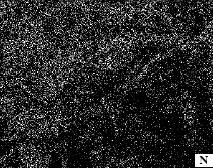 Nitrogen absent in microfossils Nitrogen absent in microfossils | |
Are the microfossils recent contaminants? ...[Those who] have contended these forms represent modern biological contaminants have never set forth a hypothesis to explain a mechanism whereby recent biological materials (<150 years in age) could have nitrogen levels below the 0.5% level that can easily be detected with the EDS on the FESEM we are using. Furthermore they never try to explain how the CI1 and CM2 carbonaceous meteorites have never been found to contain all twenty protein amino acids, all life-critical nucleobases of the sugars ribose, de-oxyribose, or any of the other sugars and polysaccharides that are present (and absolutely essential) in all living organisms.
What about liquid water in comets? ...Several years ago, I wrote papers with Chandra Wickramasinghe and the late Sir Fred Hoyle in which we argued that melted ice beneath the crust could form pockets of water in which diatoms, cyanobacteria, sulfur bacteria or other microbial extremophiles might live and grow. ...The Wild 2 data announced [April 5] clearly provide support for the hypothesis that pockets of water can exist near the crust of a comet, which could very well support cyanobacteria and filamentous sulfur bacteria which could very well explain the microfossils that I am finding in the CI1 and CM2 carbonaceous meteorites.
 Fossilized bacteria in meteorites are obvious, our What'sNEW article about Hoover's latest evidence, with links and followup postings, 3 Mar 2011. Fossilized bacteria in meteorites are obvious, our What'sNEW article about Hoover's latest evidence, with links and followup postings, 3 Mar 2011.
 5 April 2011 5 April 2011
Comet Wild-2 was once wet. This conclusion comes from a team at the Lunar and Planetary Laboratory at the University of Arizona who analysed dust grains returned from the comet's coma by NASA's Stardust mission. The grains contain sulfide minerals that can only form in liquid water. Most astronomers are surprised, because they thought that comets in deep space were icy, and always too cold for ice to liquify. It is good news for cosmic ancestry, because liquid water on comets would enable them to harbor, not just frozen life, but active life. It means that aquatic bacteria, such as cyanobacteria, could conceivably grow there.
  Frozen Comet Had a Watery Past... by Daniel Stolte, The University of Arizona, 5 Apr 2011. Frozen Comet Had a Watery Past... by Daniel Stolte, The University of Arizona, 5 Apr 2011.
 Stardust Reveals Comets Were Once Wet by Richard A. Kerr, ScienceNow, 6 Apr 2011. Stardust Reveals Comets Were Once Wet by Richard A. Kerr, ScienceNow, 6 Apr 2011.
 Comets contained oceans of liquid water... is a related What'sNEW article, 30 Jul 2009. Comets contained oceans of liquid water... is a related What'sNEW article, 30 Jul 2009.
 Comets: The Delivery System is a related local webpage. Comets: The Delivery System is a related local webpage.
 Comet Rendezvous is a related section of the webpage, "Can The Theory Be Tested?" with more about Stardust. Comet Rendezvous is a related section of the webpage, "Can The Theory Be Tested?" with more about Stardust.
 24 March 2011 24 March 2011
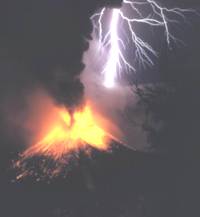 Residue from one of Stanley Miller's experiments of 1958 has been analyzed by a team including his former collaborators Jeffrey Bada and Antonio Lazcano. Miller produced this batch with an added gas, hydrogen sulfide, but if he ever analyzed it, he did not publish the results. Today's analysts report that the residue is rich in sulfur-containing amino acids. Then they note that volcanoes on early Earth might have created a gaseous mix similar to the one Miller used in this experimental setup, and that lightning could have functioned as the spark. Residue from one of Stanley Miller's experiments of 1958 has been analyzed by a team including his former collaborators Jeffrey Bada and Antonio Lazcano. Miller produced this batch with an added gas, hydrogen sulfide, but if he ever analyzed it, he did not publish the results. Today's analysts report that the residue is rich in sulfur-containing amino acids. Then they note that volcanoes on early Earth might have created a gaseous mix similar to the one Miller used in this experimental setup, and that lightning could have functioned as the spark.
Six years ago, Bada wrote, "...We still do not fully understand how life began on our planet, although there is optimism that this will change in the near future." Now his group suggests that volcanoes and lightning may have produced mixes that contain, among many other things, some pieces of life's hardware. Meanwhile, the more-difficult software aspect of the problem remains unmentioned.
We have occasionally compared origin-of-life researchers to the alchemists of renaissance science who attempted to turn base metals into gold. "The real problem with alchemy... was... that it was not sceptical enough," The Economist recently commented. We think the same is true for origin-of-life research.
 Eric T. Parker et al., "Primordial synthesis of amines and amino acids in a 1958 Miller H2S-rich spark discharge experiment" [abstract], doi:10.1073/pnas.1019191108, p5526-5531 v108, Proc. Natl. Acad. Sci. USA, 5 Apr (online 21 Mar) 2011. Eric T. Parker et al., "Primordial synthesis of amines and amino acids in a 1958 Miller H2S-rich spark discharge experiment" [abstract], doi:10.1073/pnas.1019191108, p5526-5531 v108, Proc. Natl. Acad. Sci. USA, 5 Apr (online 21 Mar) 2011.
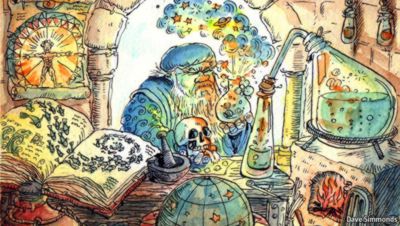
 "Alchemists, ancient and modern", illustration by Dave Simmonds, p85-86, The Economist, 26 Feb 2011. "Alchemists, ancient and modern", illustration by Dave Simmonds, p85-86, The Economist, 26 Feb 2011.
 Volcanic origin of proteins? by Hannah Waters, TheScientist, 21 Mar 2011. Volcanic origin of proteins? by Hannah Waters, TheScientist, 21 Mar 2011.
 'Lost' Miller Experiment Gives Pungent Clue to Origin of Life, NASA Goddard Release 11-23, 23 Mar 2011. 'Lost' Miller Experiment Gives Pungent Clue to Origin of Life, NASA Goddard Release 11-23, 23 Mar 2011.
 Long-Neglected Experiment Gives New Clues to Origin of Life by Sid Perkins, ScienceNow, 21 Mar 2011. Long-Neglected Experiment Gives New Clues to Origin of Life by Sid Perkins, ScienceNow, 21 Mar 2011.
 Revisiting 1950s experiments for signs of life's origin, Carnegie Institution for Science, 21 Mar 2011. Revisiting 1950s experiments for signs of life's origin, Carnegie Institution for Science, 21 Mar 2011.
 A conversation with Jeffrey L. Bada, 20 May 2010. A conversation with Jeffrey L. Bada, 20 May 2010.
 Residue from one of Stanley Miller's experiments: a reanalysis of another batch, 20 Oct 2008. Residue from one of Stanley Miller's experiments: a reanalysis of another batch, 20 Oct 2008.
 How did life on Earth originate? includes a photo of Miller in his lab, c. 1953, 4 Apr 2007. How did life on Earth originate? includes a photo of Miller in his lab, c. 1953, 4 Apr 2007.
 Jeffrey Bada's quotation above, was reported in 22 Apr 2005. Jeffrey Bada's quotation above, was reported in 22 Apr 2005.
 Revisiting the Miller Experiment, 2 May 2003. Revisiting the Miller Experiment, 2 May 2003.
 The RNA World and Other Origin-of-Life Theories is the main related local webpage. The RNA World and Other Origin-of-Life Theories is the main related local webpage.
 Thanks, Stan Franklin and Larry Klaes. Thanks, Stan Franklin and Larry Klaes.
 19 March 2011 19 March 2011
|
VIROME researchers Dan Nasko, K. Eric Wommack, Shawn Polson and Jaysheel Bhavsar |
...Scientists now appreciate that viruses contain perhaps the largest collection of unknown genes on earth. To investigate their positive genetic contributions, The University of Delaware has received a grant funding The Viral Informatics Resource for Metagenome Exploration (VIROME). Genes beneficial to higher life forms have already been observed in viruses, but we think this project will uncover many more. Viruses with genes for higher life forms are puzzling for darwinism, but expected in cosmic ancestry.
 Researchers to study positive genetic contributions of viruses by Laura Crozier, UDaily (+Physorg.com), 17 Mar 2011. Researchers to study positive genetic contributions of viruses by Laura Crozier, UDaily (+Physorg.com), 17 Mar 2011.
 Elizabeth Pennisi, "...Exploring the Role Of Viruses in Our Bodies" [summary], doi:10.1126/science.331.6024.1513, p1513 v331, Science, 25 Mar 2011. "For every bacterium in our body, there's probably 100 phages, with an estimated 10 billion of these viruses packed into each gram of human stool." Elizabeth Pennisi, "...Exploring the Role Of Viruses in Our Bodies" [summary], doi:10.1126/science.331.6024.1513, p1513 v331, Science, 25 Mar 2011. "For every bacterium in our body, there's probably 100 phages, with an estimated 10 billion of these viruses packed into each gram of human stool."
 Viruses and Other Gene Transfer Mechanisms is the main related local webpage. Viruses and Other Gene Transfer Mechanisms is the main related local webpage.
What'sNEW about HGT  | |
 Thanks, Stan Franklin. Thanks, Stan Franklin.
 17 March 2011 17 March 2011
The Cardiff Centre for Astrobiology is being closed. The research will continue in a new, limited company.
 Extra-terrestrial research goes on by Eugenie Samuel Reich, doi:10.1038/news.2011.165, NatureNews, 17 Mar 2011. Extra-terrestrial research goes on by Eugenie Samuel Reich, doi:10.1038/news.2011.165, NatureNews, 17 Mar 2011.
 Canolfan Astrobioleg Caerdydd is our announcement of the founding of the Cardiff Centre, What'sNEW, 6 Nov 2000. Canolfan Astrobioleg Caerdydd is our announcement of the founding of the Cardiff Centre, What'sNEW, 6 Nov 2000.
 12 March 2011 12 March 2011
The world is witnessing birth pangs of a paradigm shift — Chandra Wickramasinghe
 ...like the Copernican Revolution regarding genesis of life, by Walter Jayawardhana, Sinhalaya News Agency (Los Angeles), 12 Mar 2011. ...like the Copernican Revolution regarding genesis of life, by Walter Jayawardhana, Sinhalaya News Agency (Los Angeles), 12 Mar 2011.
 Chandra Wickramasinghe is a related local webpage. Chandra Wickramasinghe is a related local webpage.
 11 March 2011 11 March 2011
If these structures had been reported from sediments from a lake bottom there would be no question that they were classified correctly as biological remains — NASA astrobiologist Chris McKay
 Alien Microbe Claim Starts Fight Over Meteorite by Brandon Keim and Lisa Grossman, Wired Science, 7 Mar 2011. Alien Microbe Claim Starts Fight Over Meteorite by Brandon Keim and Lisa Grossman, Wired Science, 7 Mar 2011.
 Geologist Robert Dyer comments, 10 Mar 2011. Geologist Robert Dyer comments, 10 Mar 2011.
 9 March 2011 9 March 2011
Evidence for fossilized germs in carbonaceous metorites is too hastily dismissed. Richard Hoover's analysis and photographs (see sample), published on the Internet last week, deserve better consideration. But an Associated Press article of yesterday reveals, "McSween and other scientists said they had hoped the public would ignore reports about the study...."
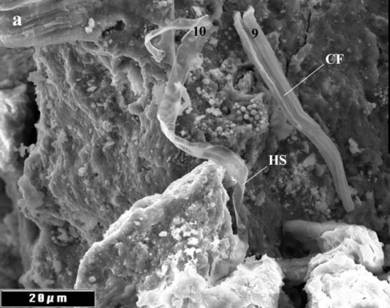 Hap McSween, a geochemist at the University of Tennessee, says that the microfossils seen by Hoover are obviously recent contaminants. But Hoover carefully considered this possibility. Recent contaminants contain the chemical signatures of life including all twenty amino acids, all five nucleobases, detectable nitrogen and phosphorus, and little-racemized chirality. Instead, these fossils are missing half the amino acids, two nucleobases, virtually all nitrogen and phosphorus; and the chirality is well-racemized. These features (lacks) are shared with multi-million-year-old fossils on Earth, and not anything recently alive. The microfossils could hardly be recent contaminants.
Hap McSween, a geochemist at the University of Tennessee, says that the microfossils seen by Hoover are obviously recent contaminants. But Hoover carefully considered this possibility. Recent contaminants contain the chemical signatures of life including all twenty amino acids, all five nucleobases, detectable nitrogen and phosphorus, and little-racemized chirality. Instead, these fossils are missing half the amino acids, two nucleobases, virtually all nitrogen and phosphorus; and the chirality is well-racemized. These features (lacks) are shared with multi-million-year-old fossils on Earth, and not anything recently alive. The microfossils could hardly be recent contaminants.
Conversely, Rosie Redfield, a microbiologist at the University of British Columbia, apparently accepts that the microfossils are ancient (came from space), but denies that they are biological. "Hoover's pictures look like microscopic versions of flattened tubes and tangled strings," in AP's paraphrase. But if McSween is right — the microfossils are contaminants — then Redfield is wrong and they are biological. Something's amiss here. And Seth Shostak of the SETI Institute disputes the evidence, saying, "If similarity in appearance were all it took to prove similarity in kind, then it would be pretty easy for me to demonstrate that there are big animals living in the sky, because I see clouds that look like them." Is he serious?
Hasty dismissal is wrong. Challenging evidence needs careful review.
 NASA disavows its scientist's claim of alien life by Seth Borenstein, Associated Press, posted on Yahoo! (+TheWashington Times), 8 Mar 2011. NASA disavows its scientist's claim of alien life by Seth Borenstein, Associated Press, posted on Yahoo! (+TheWashington Times), 8 Mar 2011.
 Scientists Dubious Over Claim of Alien Life Evidence in Meteorite by Clara Moskowitz, Space.com, 7 March 2011. Scientists Dubious Over Claim of Alien Life Evidence in Meteorite by Clara Moskowitz, Space.com, 7 March 2011.
 Fossilized bacteria in meteorites are obvious, our article about this evidence, What'sNEW, 3 Mar 2011. Fossilized bacteria in meteorites are obvious, our article about this evidence, What'sNEW, 3 Mar 2011.
 Other reactions to Hoover's evidence, What'sNEW, 7 Mar 2011. Other reactions to Hoover's evidence, What'sNEW, 7 Mar 2011.
 More Evidence for Indigenous Microfossils... is our newest related local webpage, with more photos and the basics about contamination. More Evidence for Indigenous Microfossils... is our newest related local webpage, with more photos and the basics about contamination.
 Thanks, Jim Williamson. Thanks, Jim Williamson.
 7 March 2011 7 March 2011
The latest evidence for fossilized bacteria in meteorites has created a stir. We're glad that people are noticing, even if the reactions range from sensible to stupid. A few scientists even brag that they are too smart to look at the evidence. Richard Hoover's 41-page PDF is also available from this website [local link], in case the original link doesn't work.
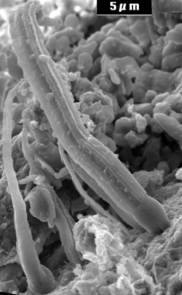
It's an extraordinary claim, and thus I'll need extraordinary evidence — David Marais, astrobiologist, NASA
 NASA Scientist Claims Evidence of Alien Life on Meteorite by Garrett Tenney, FoxNews.com, 5 Mar 2011. NASA Scientist Claims Evidence of Alien Life on Meteorite by Garrett Tenney, FoxNews.com, 5 Mar 2011.
He spends a lot of text discussing the morpohlogical similarities of these filaments to cyanobacteria, but I don't regard these similarities as worth anything — Rosie Redfield
 Is this claim of bacteria in a meteorite any better than the 1996 one? Rrresearch.Blogspot.com, 6 Mar 2011. Is this claim of bacteria in a meteorite any better than the 1996 one? Rrresearch.Blogspot.com, 6 Mar 2011.
The implication ...is that the meteorite hosted a liquid water environment in contact with sunlight and high oxygen — Chris McKay, planetary scientist and astrobiologist, NASA
 Claim of Alien Life in Meteorites Needs Further Review by Nancy Atkinson, Universe Today, 7 Mar 2011. Claim of Alien Life in Meteorites Needs Further Review by Nancy Atkinson, Universe Today, 7 Mar 2011.
 02 Oct 2018: Cyanobacteria thrive ...without light or oxygen. 02 Oct 2018: Cyanobacteria thrive ...without light or oxygen.
This work is garbage. I'm surprised anyone is granting it any credibility at all — P.Z. Myers, biologist, University of Minnesota
 Alien Life Discovered in a Meteorite! Or Maybe Not by Michael D. Lemonick, Time.com, 7 Mar 2011.
Their shapes could easily have been generated by nonliving chemical reactions — Edward Anders, retired meteoriticist, University of Chicago Alien Life Discovered in a Meteorite! Or Maybe Not by Michael D. Lemonick, Time.com, 7 Mar 2011.
Their shapes could easily have been generated by nonliving chemical reactions — Edward Anders, retired meteoriticist, University of Chicago
 Bugs From Space? Forget It by Richard A. Kerr, ScienceInsider, 7 Mar 2011.
This paper was submitted in 2007 to the International Journal of Astrobiology. However, the peer review process was not completed for that submission — Paul Hertz, chief scientist of NASA's Science Mission Directorate in Washington Bugs From Space? Forget It by Richard A. Kerr, ScienceInsider, 7 Mar 2011.
This paper was submitted in 2007 to the International Journal of Astrobiology. However, the peer review process was not completed for that submission — Paul Hertz, chief scientist of NASA's Science Mission Directorate in Washington
 NASA Statement on Astrobiology Paper by Richard Hoover, posted on spaceref.com, 7 Mar 2011. NASA Statement on Astrobiology Paper by Richard Hoover, posted on spaceref.com, 7 Mar 2011.
...They are contamination — Carl Pilcher, director of the NASA Astrobiology Institute
 NASA shoots down alien fossil claims by Kerry Sheridan, Agence France-Presse, posted on ABC News, 8 Mar 2011.
Similar assertions of bacteria-like fossil forms in a Martian meteorite, made by NASA scientists in 1996, have also been judged inconclusive. NASA shoots down alien fossil claims by Kerry Sheridan, Agence France-Presse, posted on ABC News, 8 Mar 2011.
Similar assertions of bacteria-like fossil forms in a Martian meteorite, made by NASA scientists in 1996, have also been judged inconclusive.
 The aliens haven't landed by Philip Ball, doi:10.1038/news.2011.147, NatureNews, 8 Mar 2011. The aliens haven't landed by Philip Ball, doi:10.1038/news.2011.147, NatureNews, 8 Mar 2011.
 Fossilized bacteria in meteorites are obvious, our first notice of the latest evidence, What'sNEW, 3 Mar 2011. Fossilized bacteria in meteorites are obvious, our first notice of the latest evidence, What'sNEW, 3 Mar 2011.
 Thanks, everyone. Thanks, everyone.
 3 March 2011 3 March 2011
Fossilized bacteria in meteorites are obvious in a newly published article by NASA's Richard Hoover. The prevailing counter-argument is that the fossils are earthly contaminants, but Hoover makes a convincing rebuttal. He also discusses more microfossils, other meteorites, and related topics such as life as the explanation for Europa's unusual coloring.
 Richard B. Hoover, "Fossils of Cyanobacteria in CI1 Carbonaceous Meteorites: Implications to Life on Comets, Europa, and Enceladus" [ResearchGate | local PDF], Journal of Cosmology, online 3 Mar 2011. Richard B. Hoover, "Fossils of Cyanobacteria in CI1 Carbonaceous Meteorites: Implications to Life on Comets, Europa, and Enceladus" [ResearchGate | local PDF], Journal of Cosmology, online 3 Mar 2011.
"Figure 2.a. is a low magnification (1000X) Secondary Electron Detector (SED) FESEM image of freshly fractured fragment of the Orgueil CI1 meteorite that is densely populated with several different types of embedded filaments and electron transparent sheaths. Even though the field of view shown of this image is very small (~120 μm wide) a wide variety of diverse filamentous microstructures are present...." Labels and numbering tie to descriptions in the full article, linked above.
|
 Fossilized Life Forms in the Murchison Meteorite has more about Hoover's earlier work, posted 29 Jul 1997. Fossilized Life Forms in the Murchison Meteorite has more about Hoover's earlier work, posted 29 Jul 1997.
 Fossilized Magnetotactic Bacterium in the Orgueil Meteorite is a related local webpage, posted 8 Sep 1998. Fossilized Magnetotactic Bacterium in the Orgueil Meteorite is a related local webpage, posted 8 Sep 1998.
 Evidence for Indigenous Microfossils... has photos and collected articles by Hoover. Evidence for Indigenous Microfossils... has photos and collected articles by Hoover.
 More Evidence for Indigenous Microfossils... has more photos and the rebuttal basics, posted 15 Aug 2010. More Evidence for Indigenous Microfossils... has more photos and the rebuttal basics, posted 15 Aug 2010.
 ...Created a stir — reactions to this news, What'sNEW, 7 Mar, ...Created a stir — reactions to this news, What'sNEW, 7 Mar,
 9 Mar, 9 Mar,  11 Mar — Hoover responds, 11 Mar — Hoover responds,  07 Apr 2011. 07 Apr 2011.
 Andrew C. Revkin, "NASA Scientist Sees Signs of Life in Meteorites" The New York Times, 5 Mar 2011. Andrew C. Revkin, "NASA Scientist Sees Signs of Life in Meteorites" The New York Times, 5 Mar 2011.
 Evidence for microfossils in meteorites gets a laughable rebuttal.... What'sNEW, 13 Feb 2012. Evidence for microfossils in meteorites gets a laughable rebuttal.... What'sNEW, 13 Feb 2012.
 Richard Hoover responds to Caleb Scharf's blog, What'sNEW, 15-21 Oct 2012. Richard Hoover responds to Caleb Scharf's blog, What'sNEW, 15-21 Oct 2012.
 Meteorite Contamination and "The Dog that Didn't Bark" [docx | pdf], by Richard Hoover, 13 Jun 2016. Meteorite Contamination and "The Dog that Didn't Bark" [docx | pdf], by Richard Hoover, 13 Jun 2016.
 02 Oct 2018: Cyanobacteria thrive in the deep continental subsurface without light or oxygen. 02 Oct 2018: Cyanobacteria thrive in the deep continental subsurface without light or oxygen.
 16 Mar 2021: A new examination of the Orgueil meteorite is published. 16 Mar 2021: A new examination of the Orgueil meteorite is published.
|
 An analysis of long-running evolution experiments has been done by biochemist Michael Behe (pictured) of Lehigh University. The adaptive changes observed in the experiments come from genetic mutations like insertions, deletions, substitutions, rearrangements, etc. Regardless of their phenotypic consequences, Behe categorizes each mutated coding element as having undergone either a loss, modification, or gain of function. We welcome his attention to this important area of research.
An analysis of long-running evolution experiments has been done by biochemist Michael Behe (pictured) of Lehigh University. The adaptive changes observed in the experiments come from genetic mutations like insertions, deletions, substitutions, rearrangements, etc. Regardless of their phenotypic consequences, Behe categorizes each mutated coding element as having undergone either a loss, modification, or gain of function. We welcome his attention to this important area of research.
 Bacteria can grow at 400,000 Gs, according to a research team at the Japan Agency for Marine-Earth Science and Technology. Using a centrifuge to measure cell density, the researchers were surprised when the subject E. coli continued to multiply at 7,500 Gs. They decided to measure the upper limit of this capability and found that, for some species, it exceeds the highest G-force attainable with the centrifuge. They conclude, "the habitability of extraterrestrial environments must not be limited by gravity."
Bacteria can grow at 400,000 Gs, according to a research team at the Japan Agency for Marine-Earth Science and Technology. Using a centrifuge to measure cell density, the researchers were surprised when the subject E. coli continued to multiply at 7,500 Gs. They decided to measure the upper limit of this capability and found that, for some species, it exceeds the highest G-force attainable with the centrifuge. They conclude, "the habitability of extraterrestrial environments must not be limited by gravity."
 How important is lateral gene transfer? That's the title of a recent blog entry by Jerry A. Coyne (right), Professor in the Department of Ecology and Evolution at the University of Chicago and an influential writer about evolution. The issue for him and most respondents is whether this process might invalidate the "tree of life" concept. The consensus seems to be: Not much. But respondent Michael Syvanen, coeditor of Horizontal Gene Transfer (1999), writes, "Horizontal gene transfer is the new fact of life that makes those [treelike taxonomy] rules obsolete." We, too, entered a comment on Coyne's blog about an issue important to us. Our comment, apparently disallowed, is copied in the box below.
How important is lateral gene transfer? That's the title of a recent blog entry by Jerry A. Coyne (right), Professor in the Department of Ecology and Evolution at the University of Chicago and an influential writer about evolution. The issue for him and most respondents is whether this process might invalidate the "tree of life" concept. The consensus seems to be: Not much. But respondent Michael Syvanen, coeditor of Horizontal Gene Transfer (1999), writes, "Horizontal gene transfer is the new fact of life that makes those [treelike taxonomy] rules obsolete." We, too, entered a comment on Coyne's blog about an issue important to us. Our comment, apparently disallowed, is copied in the box below.
 Endogenous retroviruses have undoubtedly made a major contribution to human evolution, according to Virolution, by British physician Frank Ryan. In a very readable text of ~350 pages, Ryan describes his own learning curve about evolution, starting from a physician's awareness of pathogenic viruses. The narration includes interactions with other leading scientists whose discoveries contributed to the new understanding. Among a plethora of examples, Ryan studies a viral plague afflicting koalas, and he predicts that they will emerge with an evolutionary advance. He even suspects that AIDS could be acting similarly among humans; he calls this phenomenon "agressive symbiosis." Other examples of "symbiogenesis" and "hybridogenesis" span all domains of life. Some useful biology lessons are included, as well as discussions of epigenetics and epidemiology.
Endogenous retroviruses have undoubtedly made a major contribution to human evolution, according to Virolution, by British physician Frank Ryan. In a very readable text of ~350 pages, Ryan describes his own learning curve about evolution, starting from a physician's awareness of pathogenic viruses. The narration includes interactions with other leading scientists whose discoveries contributed to the new understanding. Among a plethora of examples, Ryan studies a viral plague afflicting koalas, and he predicts that they will emerge with an evolutionary advance. He even suspects that AIDS could be acting similarly among humans; he calls this phenomenon "agressive symbiosis." Other examples of "symbiogenesis" and "hybridogenesis" span all domains of life. Some useful biology lessons are included, as well as discussions of epigenetics and epidemiology.

 The latest report from the MSU team observes that a fast-evolving population eventually lost out to a stodgier one by becoming trapped on a lower fitness plateau. Of course this is interesting. But we are most interested by what hasn't happened — no new genetic programs. Incidentally, in this experiment fitness is measured by direct competition between populations. If one population outgrows (outnumbers) the other, it is, by definition, more fit. But this measure says nothing about new genetic programs for new systems or features.
The latest report from the MSU team observes that a fast-evolving population eventually lost out to a stodgier one by becoming trapped on a lower fitness plateau. Of course this is interesting. But we are most interested by what hasn't happened — no new genetic programs. Incidentally, in this experiment fitness is measured by direct competition between populations. If one population outgrows (outnumbers) the other, it is, by definition, more fit. But this measure says nothing about new genetic programs for new systems or features.

 Are the microfossils nonbiological "extrusions"? ...CI1 carbonaceous meteorites are microregolith breccias in which the tiny mineral grains are cemented together with epsomite and other water soluble salts. ...[The proponent of extrusions] fails to cite any publications with examples and images in terrestrial rocks in which his extrusions have been found which exhibit the size and detailed morphologies of any recognizable genera and species of filamentous cyanobacteria of the Orders Oscillatoriaceae, Nostocaceae and Stigonometaceae that could be accepted as biological by any phycologist.
Are the microfossils nonbiological "extrusions"? ...CI1 carbonaceous meteorites are microregolith breccias in which the tiny mineral grains are cemented together with epsomite and other water soluble salts. ...[The proponent of extrusions] fails to cite any publications with examples and images in terrestrial rocks in which his extrusions have been found which exhibit the size and detailed morphologies of any recognizable genera and species of filamentous cyanobacteria of the Orders Oscillatoriaceae, Nostocaceae and Stigonometaceae that could be accepted as biological by any phycologist.

 Residue from one of Stanley Miller's experiments of 1958 has been analyzed by a team including his former collaborators Jeffrey Bada and Antonio Lazcano. Miller produced this batch with an added gas, hydrogen sulfide, but if he ever analyzed it, he did not publish the results. Today's analysts report that the residue is rich in sulfur-containing amino acids. Then they note that volcanoes on early Earth might have created a gaseous mix similar to the one Miller used in this experimental setup, and that lightning could have functioned as the spark.
Residue from one of Stanley Miller's experiments of 1958 has been analyzed by a team including his former collaborators Jeffrey Bada and Antonio Lazcano. Miller produced this batch with an added gas, hydrogen sulfide, but if he ever analyzed it, he did not publish the results. Today's analysts report that the residue is rich in sulfur-containing amino acids. Then they note that volcanoes on early Earth might have created a gaseous mix similar to the one Miller used in this experimental setup, and that lightning could have functioned as the spark.


 Hap McSween, a geochemist at the University of Tennessee, says that the microfossils seen by Hoover are obviously recent contaminants. But Hoover carefully considered this possibility. Recent contaminants contain the chemical signatures of life including all twenty amino acids, all five nucleobases, detectable nitrogen and phosphorus, and little-racemized chirality. Instead, these fossils are missing half the amino acids, two nucleobases, virtually all nitrogen and phosphorus; and the chirality is well-racemized. These features (lacks) are shared with multi-million-year-old fossils on Earth, and not anything recently alive. The microfossils could hardly be recent contaminants.
Hap McSween, a geochemist at the University of Tennessee, says that the microfossils seen by Hoover are obviously recent contaminants. But Hoover carefully considered this possibility. Recent contaminants contain the chemical signatures of life including all twenty amino acids, all five nucleobases, detectable nitrogen and phosphorus, and little-racemized chirality. Instead, these fossils are missing half the amino acids, two nucleobases, virtually all nitrogen and phosphorus; and the chirality is well-racemized. These features (lacks) are shared with multi-million-year-old fossils on Earth, and not anything recently alive. The microfossils could hardly be recent contaminants.

